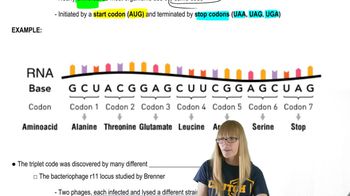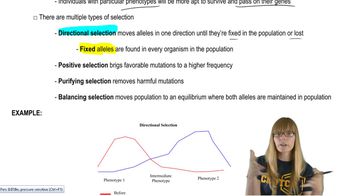A portion of a DNA template strand has the base sequence 5′-...ACGCGATGCGTGATGTATAGAGCT...-3′
Identify the sequence and polarity of the mRNA transcribed from this fragmentary template-strand sequence.
Ch. 9 - The Molecular Biology of Translation
Chapter 9, Problem 6
What are the differences between the universal code and that found in the mitochondria of some species? Given that some changes (UGA =stop→Trp) have occurred multiple independent times in evolution, can you think of any selective advantage to the mitochondrial code?
 Verified step by step guidance
Verified step by step guidance1
span>Step 1: Understand the universal genetic code. The universal genetic code is a set of rules by which information encoded in genetic material (DNA or RNA sequences) is translated into proteins by living cells. It is nearly universal across all organisms, with 64 codons coding for 20 amino acids and stop signals.</span
span>Step 2: Identify the differences in mitochondrial genetic codes. Mitochondrial genetic codes can differ from the universal code. For example, in human mitochondria, the codon UGA, which is a stop codon in the universal code, codes for the amino acid tryptophan (Trp).</span
span>Step 3: Explore the evolutionary changes. Some changes in the mitochondrial genetic code, such as UGA coding for Trp instead of a stop signal, have occurred multiple times independently in evolution. This suggests that these changes might confer some selective advantages.</span
span>Step 4: Consider potential selective advantages. One possible advantage of the mitochondrial code changes could be related to the efficiency of protein synthesis. By reassigning stop codons to amino acids, mitochondria might optimize the use of their limited genetic material, allowing for more compact and efficient genomes.</span
span>Step 5: Reflect on the implications of these changes. The changes in the mitochondrial genetic code might also reflect adaptations to specific cellular environments or energy requirements, as mitochondria are the powerhouses of the cell and play a crucial role in energy production.</span

Verified video answer for a similar problem:
This video solution was recommended by our tutors as helpful for the problem above.
Video duration:
2mWas this helpful?
Key Concepts
Here are the essential concepts you must grasp in order to answer the question correctly.
Universal Genetic Code
The universal genetic code is a set of rules by which information encoded in genetic material (DNA or RNA) is translated into proteins. It consists of 64 codons, which correspond to 20 amino acids and serve as the foundation for protein synthesis in nearly all organisms. This code is largely conserved across species, highlighting the common evolutionary heritage of life.
Recommended video:
Guided course

The Genetic Code
Mitochondrial Genetic Code
The mitochondrial genetic code is a variation of the universal code, used specifically by mitochondria, the energy-producing organelles in eukaryotic cells. This code differs in certain codon assignments, such as UGA, which typically signals a stop codon in the universal code but can code for tryptophan in some mitochondrial contexts. These variations reflect adaptations to the unique environment and functions of mitochondria.
Recommended video:
Guided course

The Genetic Code
Selective Advantage
Selective advantage refers to a trait or characteristic that increases an organism's chances of survival and reproduction in a given environment. In the context of mitochondrial code variations, such as the reassignment of UGA, these changes may confer benefits like enhanced protein synthesis efficiency or adaptability to specific metabolic needs, potentially leading to evolutionary advantages in certain species.
Recommended video:
Guided course

Natural Selection
Related Practice
Textbook Question
430
views
Textbook Question
A portion of a DNA template strand has the base sequence 5′-...ACGCGATGCGTGATGTATAGAGCT...-3′
Which is the third amino acid added to the polypeptide chain?
300
views
Textbook Question
A portion of a DNA template strand has the base sequence 5′-...ACGCGATGCGTGATGTATAGAGCT...-3′
Assume the mRNA is written in the correct reading frame. Determine the amino acid sequence encoded by this fragment. Identify the N- and C-terminal directions of the polypeptide.
327
views
Textbook Question
Describe three features of tRNA molecules that lead to their correct charging by tRNA synthetase enzymes.
255
views
Textbook Question
Identify the amino acid carried by tRNAs with the following anticodon sequences.
5′-UAG-3′
232
views
Textbook Question
Identify the amino acid carried by tRNAs with the following anticodon sequences.
5′-AAA-3′
214
views
